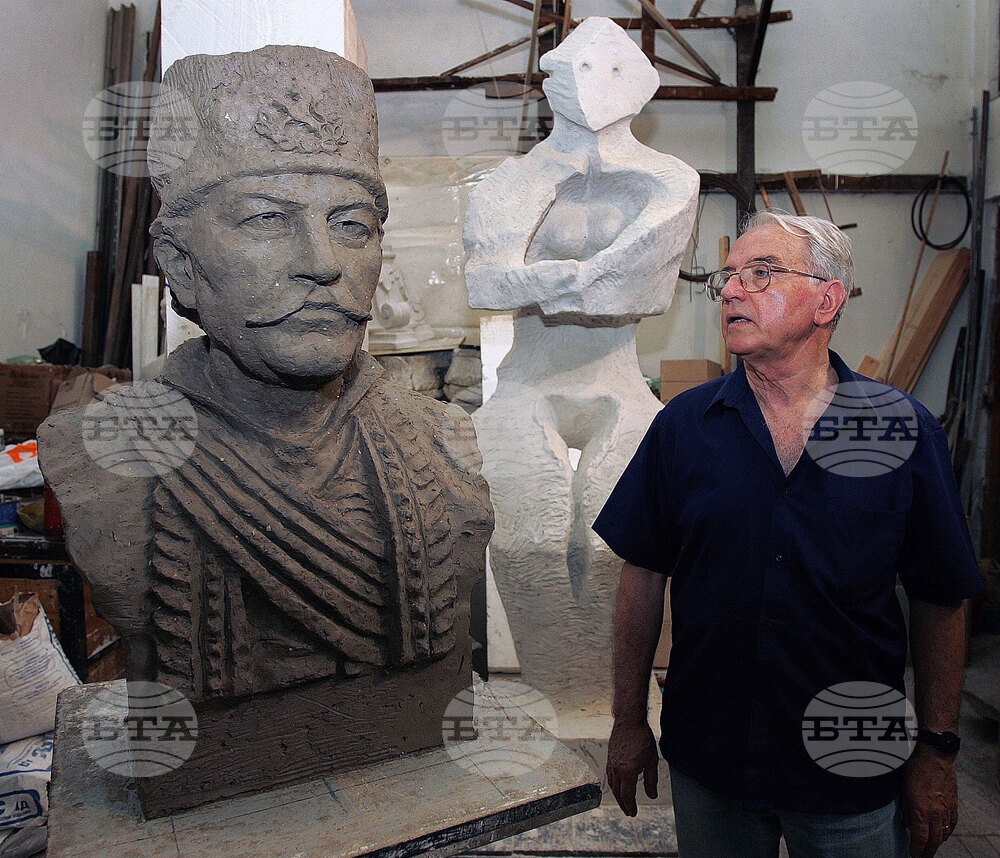site.btaSculptor Valentin Starchev at 90: My Whole Life Has Been Filled with Much Joy and Suffering


"My whole life has been very intense, filled with much joy and much suffering," renowned Bulgarian sculptor Valentin Starchev told BTA, as he celebrates his 90th birthday today.
"My wish is to stay alive and healthy above all, so that I can keep working a little longer," the artist said on the occasion of his anniversary. Taking short breaks, he continues to work constantly, as he is preparing a new exhibition. For now, it is scheduled for October 16 at Kvadrat 500 Gallery, Starchev said.
He has not yet disclosed how many sculptures will be displayed in the upcoming exhibition. However, he shared that birthdays make him reflect on the past and on his 70 years of creative work. "And that's interesting, because you remember many things that brought great joy, but also moments that brought deeply tragic emotions. For example, the demolition of the 1300 Years of Bulgaria monument. And the joys are different - various awards I’ve received over the years," said Starchev.
THE BEGINNING
Valentin Starchev was born on August 14, 1935, into the family of Decho and Mara Starchevi in Stara Zagora. The future sculptor attended First Junior High School from first to third grade. As a student, he participated in organized sports activities thanks to his physical education teacher, Vasil Nikolov. The activities mainly involved running, and after meeting the speed standard, Valentin Starchev became the school’s fastest sprinter in the 100 meters. He then regularly took part in competitions in the city. He began training in athletics with the Udarniк sports club, and before finishing high school, he set his first national youth record in the 200 meters – 22.4 seconds.
In high school, his art teacher was Kipro Nikolov, a painter who had participated in numerous exhibitions and had his own studio. He was the one who introduced Starchev to art. Under his guidance, Valentin Starchev gained knowledge about using paints and learned the ABCs of painting. Kipro Nikolov encouraged the budding artist to apply to the Academy of Fine Arts and took on the task of preparing him for the entrance exams.
THE FIRST SUCCESSES
In 1953, Valentin Starchev was admitted to study at the Academy of Fine Arts. Even as a student, he won a competition for the design of the fountain at the entrance to Ayazmoto Park in Stara Zagora. His graduation project was called Discus Thrower. He recalls how his professor, Prof. Marko Markov, reacted to it:
"He looked at me and asked, ‘So, are you going to be a sculptor or an athlete? Let’s make that clear!’”
Valentin Starchev graduated from the Academy of Fine Arts in 1959. Until 1964, he worked as a freelance artist. In 1961, he won second prize at the First Youth Exhibition with Wrestlers, which was acquired by the Ruse Art Gallery. After that, he was accepted as a member of the Union of Bulgarian Artists.
In 1964, after a competitive selection, he became a lecturer at the Higher Institute of Architecture and Civil Engineering (now the University of Architecture, Civil Engineering, and Geodesy), in the Department of Drawing and Modeling within the Faculty of Architecture. Ten years later, he was promoted to Associate Professor, and in 1982 he became a Full Professor. From 1985, he served as Head of the Department.
From June 22, 1979, to June 28, 1985, Valentin Starchev was Secretary of the Union of Bulgarian Artists, and from June 28, 1985, to April 1989, he served as its Deputy Chairman.
THE ART
"Regardless of the regimes and the times, the whole world preserves its architecture and visual arts, because through them we gather information about what life was like through the centuries," the sculptor said in an interview for the Sega newspaper in 2005.
Valentin Starchev’s work encompasses easel sculpture, decorative and monumental compositions in harmony with architecture, portraits, medals, and coins. His easel compositions include: The Baptism (1972, Sofia City Art Gallery). Execution (1973, Stara Zagora Art Gallery). Pieta (1974, National Art Gallery), The Foundry Worker (1976, Middelheim Museum of Contemporary Art, Belgium), Klokotnitsa 1230 (1978, Veliko Tarnovo Art Gallery), The Jump (1980, USSR), Pieta (1983, Vatican).
ARTWORKS
His monumental works include: The Brothers' Mound, commemorating those who died for freedom in Pleven, created with architect Hristo Kovachev (1978), The 1300 Years of Bulgaria Monument (1981, in front of the National Palace of Culture in Sofia, dismantled in 2017), The Birth of the Party (1981, the Buzludzha Monument), Pegasus Monument, honoring fallen Bulgarian writers, located in front of the Union of Bulgarian Writers in Sofia, The Monument to Captain Petko Voyvoda, on the Garibaldi Alley in Rome, Italy.
Among his decorative panels are works in the Grand Hotel Sofia, the University of Architecture, Civil Engineering and Geodesy, the Cultural Complex in Pravets, and the Cultural Center in Chiprovtsi.
When asked by The Puls newspaper in 1981 what he aims to express through his art, Starchev replied: "Sculpture is the art of the moment, carried into eternity."
His works are held in numerous galleries and private collections in Bulgaria, Italy, the USA, the Netherlands, Belgium, Japan, France, Austria, and more. He has held both solo and group exhibitions in Bulgaria and abroad.
Valentin Starchev’s artworks have been gifted to notable figures such as Pope John Paul II, King Juan Carlos of Spain (1975–2014), and Austrian conductor Herbert von Karajan, among others. He has received numerous honors, including: Merited Artist (1977), People’s Artist (1986), Dimitrov Prize (1980), Medusa Aurea Gold Award for 1979–1980 from the International Competition of the Italian Academy of Modern Art in Rome (1980), for his work Pieta, the Union of Bulgarian Artists Award (1981), Order of the People's Republic of Bulgaria, 2nd Class (1985), the Golden Age Award from the Ministry of Culture (2015).
Valentin Starchev is also a member of the Salon d’Automne in Paris, France.
/PP/
news.modal.header
news.modal.text
